Best AI tools for product managers. Here’s our top 8.
Explore the top 8 AI tools that empower product managers to enhance productivity, streamline workflows, and analyze customer feedback effectively.

AI tools are transforming product management by saving time, improving decision-making, and boosting productivity. From analyzing customer feedback to creating roadmaps, these tools address key challenges product managers face daily. Below are 8 top AI tools that can make your work easier and more efficient:
- BuildBetter: Combines team communications and customer feedback into actionable insights. Starting at $7.99/month.
- ChatGPT: Assists with strategic planning, automating tasks like PRD creation and market analysis. Available for $20/month (Plus).
- Zeda.io: Centralizes feedback and links it to revenue growth for better prioritization. Starts at $59/month.
- H2O.ai: Offers predictive analytics using machine learning for forecasting and anomaly detection. Custom pricing.
- ProdPad CoPilot: Simplifies roadmap creation and aligns product goals. Starting at $6/month per user.
- Jam: Streamlines bug reporting with instant screen recordings and technical details. Free for individuals.
- Monterey AI: Analyzes unstructured customer feedback to highlight trends and actionable insights. Custom pricing.
- Delibr: Helps create structured PRDs with AI-assisted templates and real-time collaboration. Starting at $100/month.
Quick Comparison
| Tool | Focus | Workflow Efficiency | Data Analysis | Collaboration Features | Starting Price |
|---|---|---|---|---|---|
| BuildBetter | Unified insights | Automates call transcription and insight generation | Combines team and customer data | Real-time AI chat | $7.99/month |
| ChatGPT | Strategic planning | Automates research and document creation | Text-based analysis | Basic conversation interface | $20/month (Plus) |
| Zeda.io | Product intelligence | Centralizes feedback and organizes insights | Links feedback to revenue growth | Feedback hub with alignment tools | $59/month |
| H2O.ai | Predictive analytics | Automates model creation for forecasting | Advanced ML models | Model sharing for data teams | Custom pricing |
| ProdPad | Roadmap management | Automates roadmaps and product planning | Feature impact assessment | Roadmap sharing tools | $6/month per user |
| Jam | Technical collaboration | Automates bug reporting with screen recordings | Visual debugging | Real-time issue collaboration | Free (individual) |
| Monterey AI | Customer feedback analysis | Automates feedback processing | Sentiment analysis and behavior insights | Insight sharing across teams | Custom pricing |
| Delibr | PRD creation | AI-assisted templates for structured documents | Limited to document organization | Real-time commenting and editing | $100/month |
These tools cater to different needs, whether you're a solo PM or part of a large team. Choose the one that aligns with your goals and budget to streamline your workflow and make better decisions.
AI for Product Managers - Top AI Tools for PMs & The Future of Product Management | HelloPM
1. BuildBetter for Unified Insights
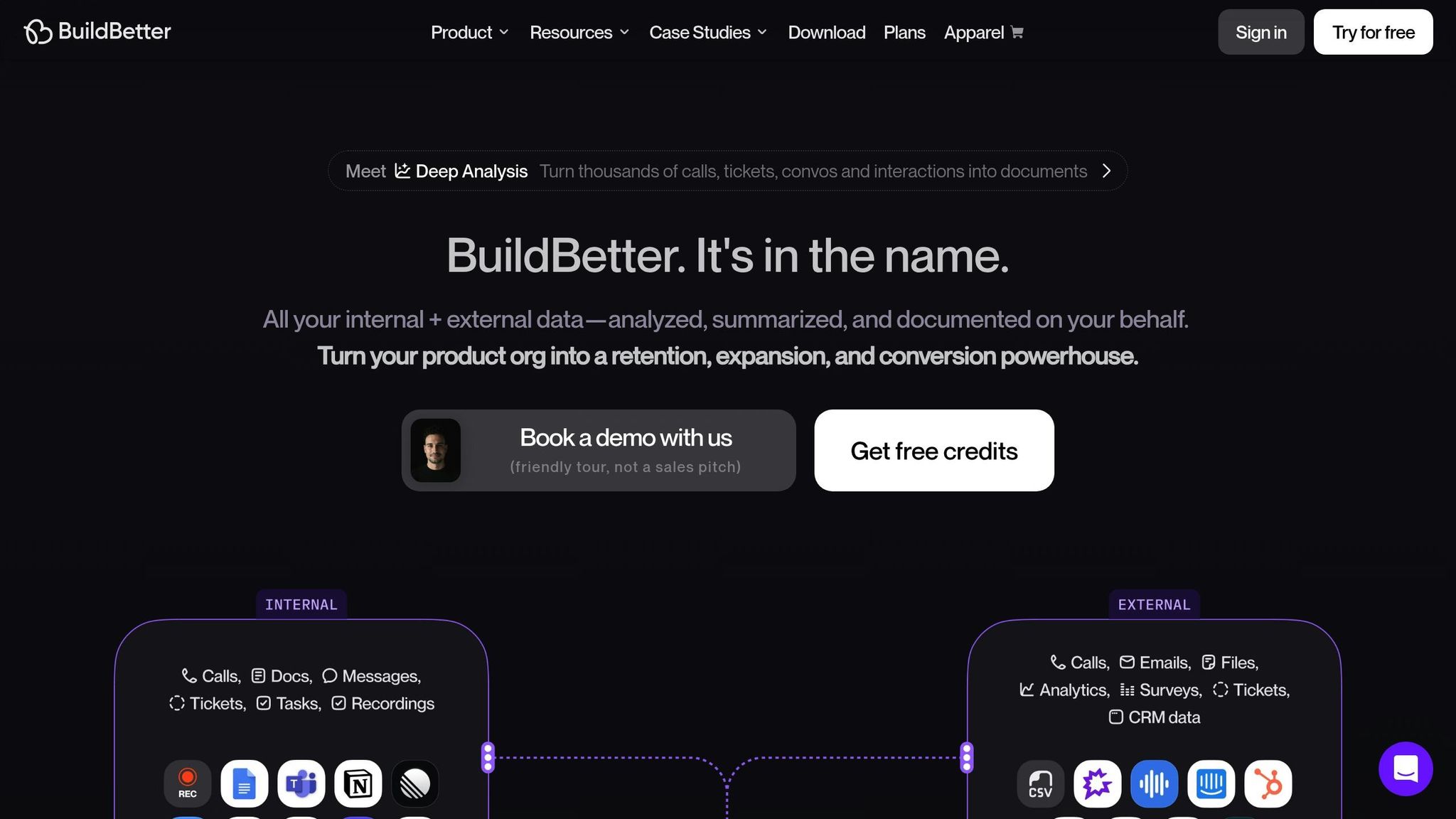
BuildBetter stands out as a top AI tool, showcasing how integrated insights can elevate product development. By combining internal team communications with over 100 external integrations - like Zoom, Salesforce, Zendesk, HubSpot, and Intercom - it provides a full-spectrum view of product data.
Workflow Optimization
BuildBetter takes the hassle out of daily admin tasks with its seamless data integration. It automatically records meetings and logs chats through its no-bot desktop and mobile apps, turning them into actionable status updates and insights. Product managers can assign tasks directly from meeting notes or Slack discussions, ensuring nothing important gets overlooked. This saves time and reduces the need for constant follow-ups.
Data Analysis and Insights
Beyond simplifying workflows, BuildBetter shines when it comes to organizing and analyzing unstructured data. It transforms scattered qualitative information into structured, research-grade documents that help teams make smarter decisions. By diving into data from multiple sources, it uncovers patterns in customer behavior, market trends, and product performance. This gives product managers the edge they need to create products that align with user preferences.
The platform also includes a real-time AI chat feature, making it easy to query internal company knowledge. Whether you need details on past decisions, feedback trends, or project updates, you can access the information instantly without digging through endless files.
Collaboration Features
BuildBetter strengthens team collaboration by delivering smart meeting summaries and automated briefs that boost alignment across projects. It pulls data from meeting transcripts and Slack channels to create updates, enhancing visibility and accountability.
Team members can revisit meeting transcripts to focus on specific topics, ensuring continuity across projects and stakeholder conversations. Advanced permission settings keep sensitive data secure while meeting compliance standards like GDPR, HIPAA, and SOC 2 Type 2. These features make it easier for product managers to strategize effectively.
Practical Applications for Product Management
For product managers, BuildBetter simplifies the creation of PRDs, user personas, and insight reports. It organizes feedback into structured formats that aid in strategic planning and feature prioritization. By analyzing customer conversations, support tickets, and team discussions, it also tracks key performance indicators, helping teams spot market opportunities and identify emerging trends.
To meet diverse team needs, BuildBetter offers flexible pricing plans:
- Starter: $7.99/month (unlimited seats, 120 minutes)
- Growing: $200/month (3,600 minutes, unlimited reports)
- Scaling: $800/month (16,000 minutes)
- Enterprise: Custom pricing with unlimited processing and dedicated support.
This range ensures that teams of all sizes can benefit from BuildBetter's capabilities.
2. ChatGPT for Strategic Planning
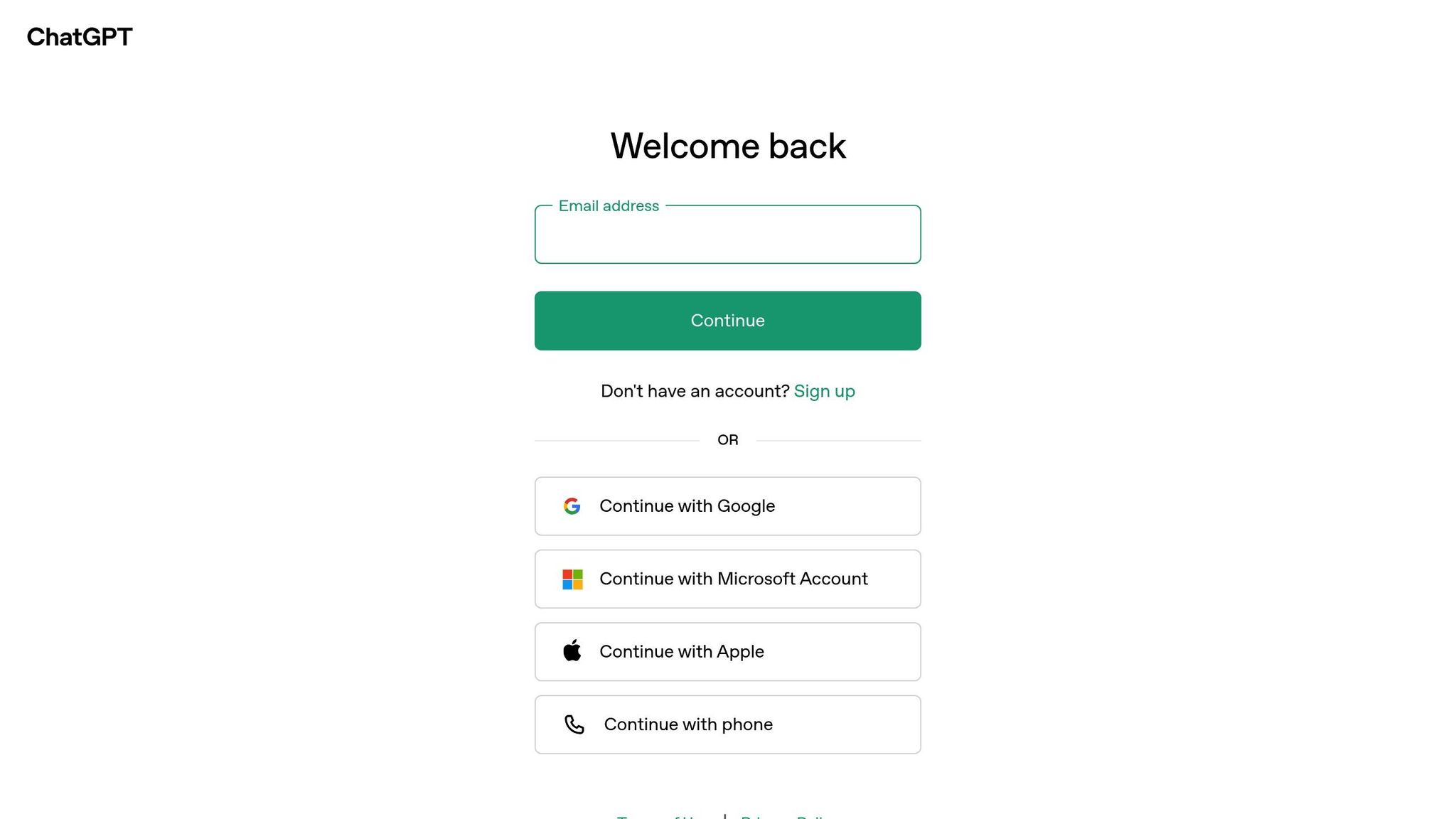
ChatGPT acts as a powerful assistant for product managers, helping to break down complex challenges and offering structured frameworks for essential product decisions.
Workflow Optimization
ChatGPT simplifies the workload by automating tasks like research, drafting PRDs (Product Requirement Documents), creating user stories, and conducting pre-mortem analyses to pinpoint potential failure points and suggest mitigation strategies. It also handles the creation of key documents such as presentations, meeting agendas, and strategic reports, cutting down on manual effort.
"Use ChatGPT as your automated co-pilot which can help you save time, create initial drafts, summarize stuff, etc. Do not try to rely completely on ChatGPT as it hallucinates, sometimes gives wrong information, and is trained on data from the past." - HelloPM
By taking care of repetitive administrative tasks, ChatGPT allows product managers to focus on higher-level strategic work. It also generates structured templates for competitor analysis and market research, creating a more efficient workflow that leads to deeper insights.
Data Analysis and Insights
Building on its ability to streamline workflows, ChatGPT turns raw data into actionable insights through advanced analysis. It simplifies market sizing by organizing calculations for TAM (Total Addressable Market), SAM (Serviceable Addressable Market), and SOM (Serviceable Obtainable Market). It also identifies patterns in customer data, helping product managers design products that stay ahead of market trends.
ChatGPT enhances competitor analysis by structuring evaluation frameworks and extracting insights from market positioning data. It can perform sentiment analysis on customer feedback, categorize responses, and provide strategic recommendations based on user behavior trends.
Practical Applications for Product Management
These features enable product managers to make quick, informed decisions that align with broader business goals. ChatGPT can create multi-year product roadmaps with quarterly breakdowns, organize features like "In-app flow builder, survey templates, Product usage analytics" into clear timelines, and assist in feature prioritization by analyzing impact and value propositions.
The platform also supports strategic decision-making by conducting market research, analyzing target audiences, identifying trends, and evaluating risks for various product strategies . Additionally, it helps define key product goals and establish data collection methods by creating detailed metrics trees.
When it comes to resource allocation and strategic planning, ChatGPT serves as a valuable analytical partner. While it provides robust support, the final decisions remain firmly in the hands of human judgment.
3. Zeda.io for Product Intelligence

Zeda.io takes customer feedback and transforms it into actionable insights, making it a powerful tool for product intelligence. By centralizing feedback and streamlining workflows, it helps product teams make smarter decisions and execute strategies more efficiently.
Workflow Optimization
Zeda.io simplifies product management by centralizing tools and data, saving teams over 90 hours of collaboration time and cutting strategy development time by two-thirds. Its customizable dashboards offer a clear view of all activities, from prioritizing tasks to tracking progress. Routine tasks like status updates, Jira integration, and feedback tagging are automated, drastically reducing manual effort - a critical feature since 52% of product managers report struggling with the growing complexity of feature management.
The platform also integrates with tools like Mixpanel and Google Data Studio, enabling seamless usage tracking and dependency management. This integration ensures a unified workflow, laying the foundation for deeper data-driven insights.
Data Analysis and Insights
Zeda.io excels at turning raw customer data into meaningful insights. It automatically gathers customer feedback, eliminating the need for manual collection. Using AI, it organizes feedback into clear themes, making it easier to understand and act on.
One standout feature is its ability to link customer feedback to revenue growth potential. The platform generates AI-driven reports that include details like feedback source, customer segment, revenue impact, and tags, giving product managers a well-rounded view of priorities. Tools like "Ask AI" answer specific questions about customer data, while the "Opportunity Radar" predicts potential challenges and opportunities.
"It's amazing how Zeda.io focuses on revenue in product discovery and planning. It blends individual feedback with broader product insights for strategic roadmap planning, all aimed at empowering product teams to drive outcomes."
- Dan Dalton, Head of Product & Design, Flock
Collaboration Features
Zeda.io doesn’t just stop at analysis - it ensures insights are effectively shared across teams. Its centralized communication hub streamlines task management, file sharing, and live roadmap updates, cutting down on repetitive explanations. A collaborative voting system lets team members weigh in on feedback prioritization, and unlimited collaborators can join the workspace, making it easy to scale.
For instance, Salesmate, a CRM tool, used Zeda.io to improve collaboration between its Sales, Success, and Engineering teams. This led to better workflows and increased productivity.
Practical Applications for Product Management
Zeda.io simplifies the management of feature requests and bug reports, supports prioritization frameworks like RICE, and offers pre-built templates for roadmaps that can be shared live. It also helps teams turn big-picture product visions into actionable goals with defined timelines, assignees, and progress tracking.
Its documentation tools, complete with pre-written templates for PRDs and product strategies, ensure consistency and save time.
"Zeda.io is a game changer. This is by far the best way to leverage AI for customer-obsessed product teams. Product teams should definitely give it a try."
- Saurabh Pareek, Director of Product Management, PayPal
4. H2O.ai for Predictive Analytics
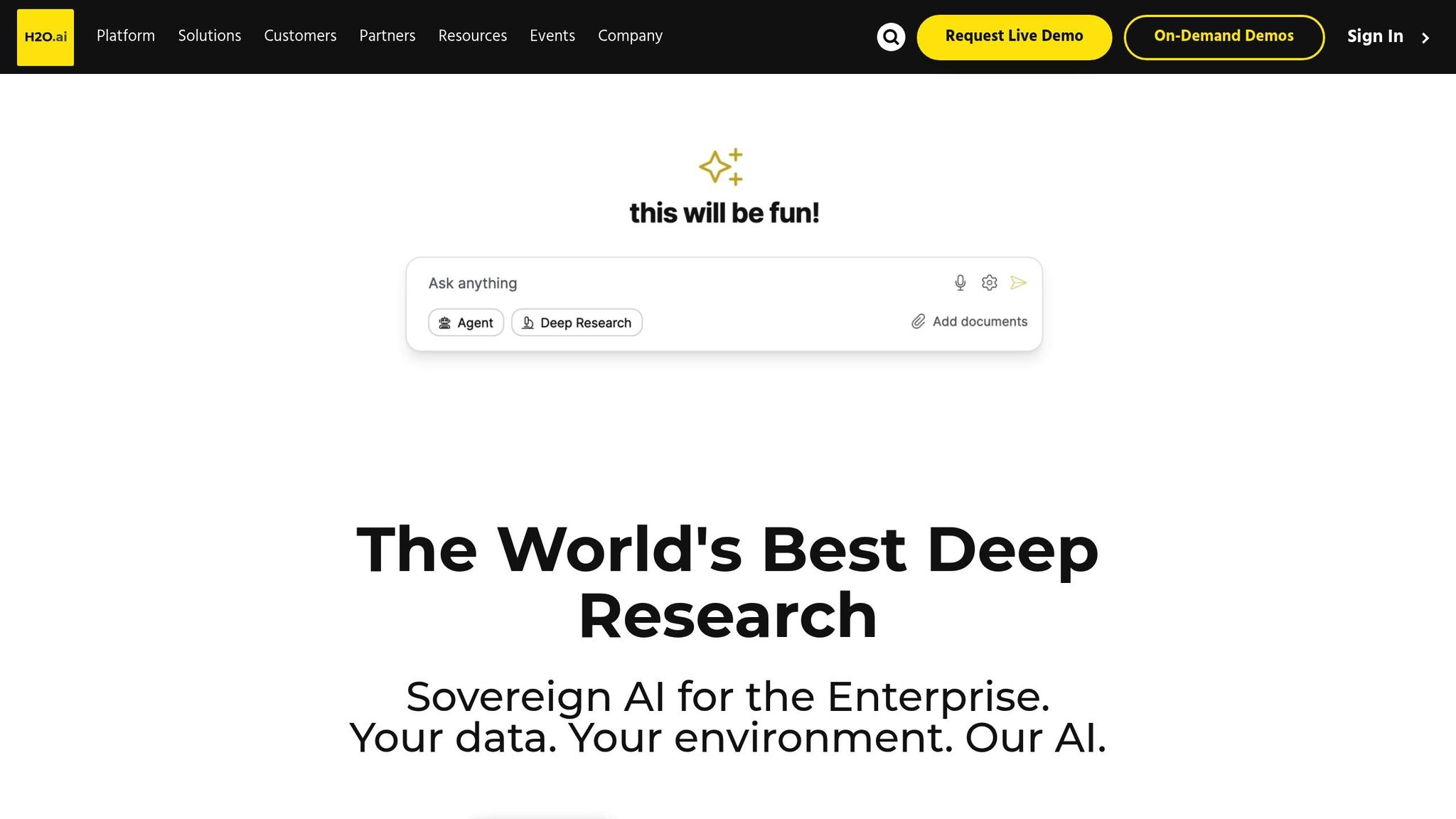
H2O.ai equips product managers with the tools to turn complex data into actionable predictions through advanced machine learning. This open-source platform is already making waves, transforming operations in over 20,000 organizations worldwide, including more than half of the Fortune 500.
Data Analysis and Insights
H2O.ai stands out for its ability to reveal hidden patterns and opportunities within large datasets, fueling strategic product innovations. Its AutoML feature simplifies the process by automating the training and tuning of multiple models within a set timeframe. This means product managers can build sophisticated predictive models quickly, even without extensive technical expertise.
The platform's H2O AI Cloud offers tools like data visualization, automated data insights, and feature engineering to streamline the analysis process. In addition, its model interpretability tools ensure that predictions are not only accurate but also easy to understand. This combination of features makes the model-building process more efficient and accessible.
Workflow Optimization
H2O.ai simplifies the traditionally intricate task of building predictive models with its intuitive web interface, H2O Flow. This visual tool allows product managers to design and visualize models without requiring advanced coding skills, significantly cutting down the time it takes to go from raw data to actionable insights.
Another standout feature, H2O Driverless AI, compresses tasks that would typically take months into just minutes, eliminating the need for expert-level coding. This speed enables faster iterations and more timely decision-making.
The platform also supports ongoing learning by scheduling regular model retraining as new data becomes available.
"H2O Driverless AI gives amazing performance in terms of feature performance and also model performance." - Venkatesh Ramanathan, Senior Data Scientist, PayPal
Practical Applications for Product Management
H2O.ai empowers product managers to automate key tasks like lead scoring, churn prediction, customer segmentation, and product recommendations. These insights pave the way for proactive and data-driven strategies in product management.
In predictive maintenance, the platform leverages data from IoT sensors, manufacturing processes, and environmental factors to predict when components should be replaced before they fail. This approach can lead to a 10% reduction in annual maintenance costs, up to a 25% drop in downtime, and a 25% cut in inspection expenses, making it especially useful for managers dealing with physical products or manufacturing.
H2O.ai also excels in areas like fraud detection and pricing optimization, showcasing its flexibility across various industries and product categories.
A compelling example of H2O.ai's enterprise impact comes from AT&T. The telecom giant is collaborating with H2O.ai to implement the H2O AI Feature Store for managing large-scale, real-time workloads. According to Prince Paulraj, AVP of Data Science at AT&T, their use of H2O's AI Cloud services is "going to be one of the most impactful elements in their platform, building AI solutions that are much faster, more accurate and robust in a fraction of the time".
Collaboration Features
H2O.ai's H2O AI Feature Store centralizes feature management, improving efficiency, governance, and reliability across AI projects. By ensuring teams have access to the same high-quality features, the platform promotes consistency in product development.
The platform integrates seamlessly with popular programming languages like Python and R, and it also supports tools like Apache Hadoop and Spark for managing large datasets. This flexibility allows product teams to incorporate H2O.ai into their existing workflows without major disruptions.
Additionally, H2O.ai includes explainable AI tools such as bias detection and white box models. These features help product managers effectively communicate insights to stakeholders, building trust in AI-driven decisions and fostering confidence in the outcomes.
5. ProdPad CoPilot for Roadmap Management
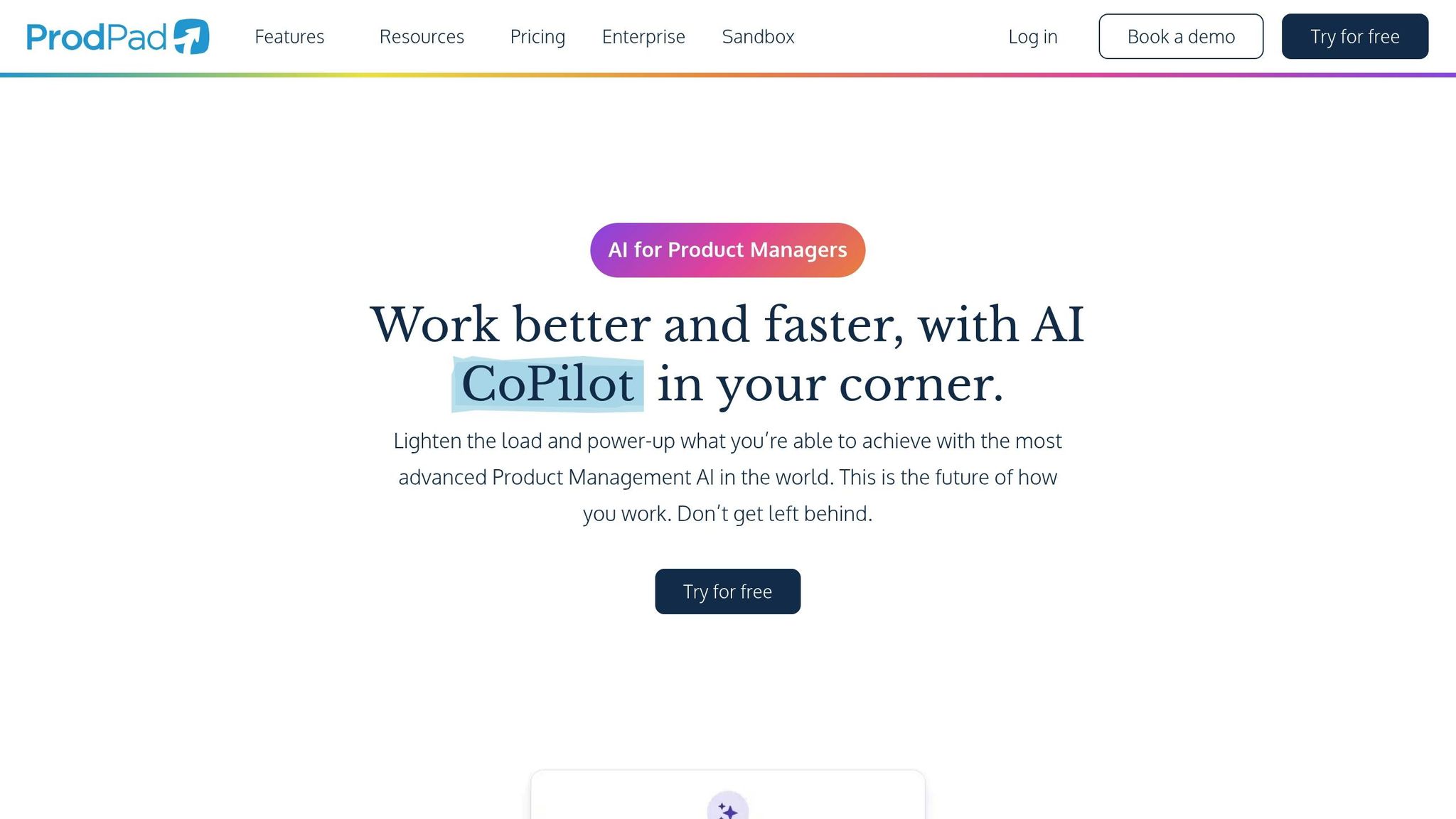
ProdPad CoPilot simplifies roadmap creation by turning planning documents into dynamic, actionable plans. Designed for product managers, this tool acts as both a strategic guide and a hands-on assistant, helping teams transition from scattered notes to well-structured, evolving roadmaps.
Workflow Optimization
Using AI, CoPilot transforms unorganized documents into structured roadmaps, automatically drafting detailed materials. It identifies potential solutions to existing challenges, enabling teams to explore different approaches efficiently. This process not only saves time but also provides valuable insights into priorities.
Data Analysis and Insights
CoPilot taps into your entire product ecosystem - roadmaps, backlogs, OKRs, and vision statements - to deliver suggestions aligned with your strategic goals. It identifies patterns in customer feedback and backlog entries, summarizes insights, links customer inputs to specific features, and flags duplicate ideas. When defining objectives and key results, it helps craft measurable outcomes that tie directly to your product vision. The tool’s ability to integrate insights with collaboration features ensures everyone stays aligned and informed.
Collaboration Features
CoPilot reduces interruptions by addressing stakeholder questions about idea statuses and prioritization. Its collaboration tools promote transparency, giving team members a clear view of backlog updates and decision-making processes. Real-time discussions integrate seamlessly with Slack and email, while contextual voting features let team members weigh in with added clarity. Ryan Troll, Cofounder & CEO of ProductMaven, highlights this transparency:
"Executives are used to seeing problems from one perspective, so we start by just making product ideas more visible to everyone. With ProdPad, you can physically put ideas in front of everybody and have transparent discussions. That gives people an excuse to reach beyond their usual circles and talk to different stakeholders. It's a small but important shift."
Practical Applications for Product Management
CoPilot supports roadmap development by generating assets from files and suggesting "Now, Next, and Later" initiatives. For daily tasks, it creates entries in ProdPad by extracting key details from documents, cutting down on manual data entry. Its recommendations for roadmap initiatives ensure teams maintain a strategic focus while balancing immediate priorities with long-term plans.
6. Jam for Technical Collaboration
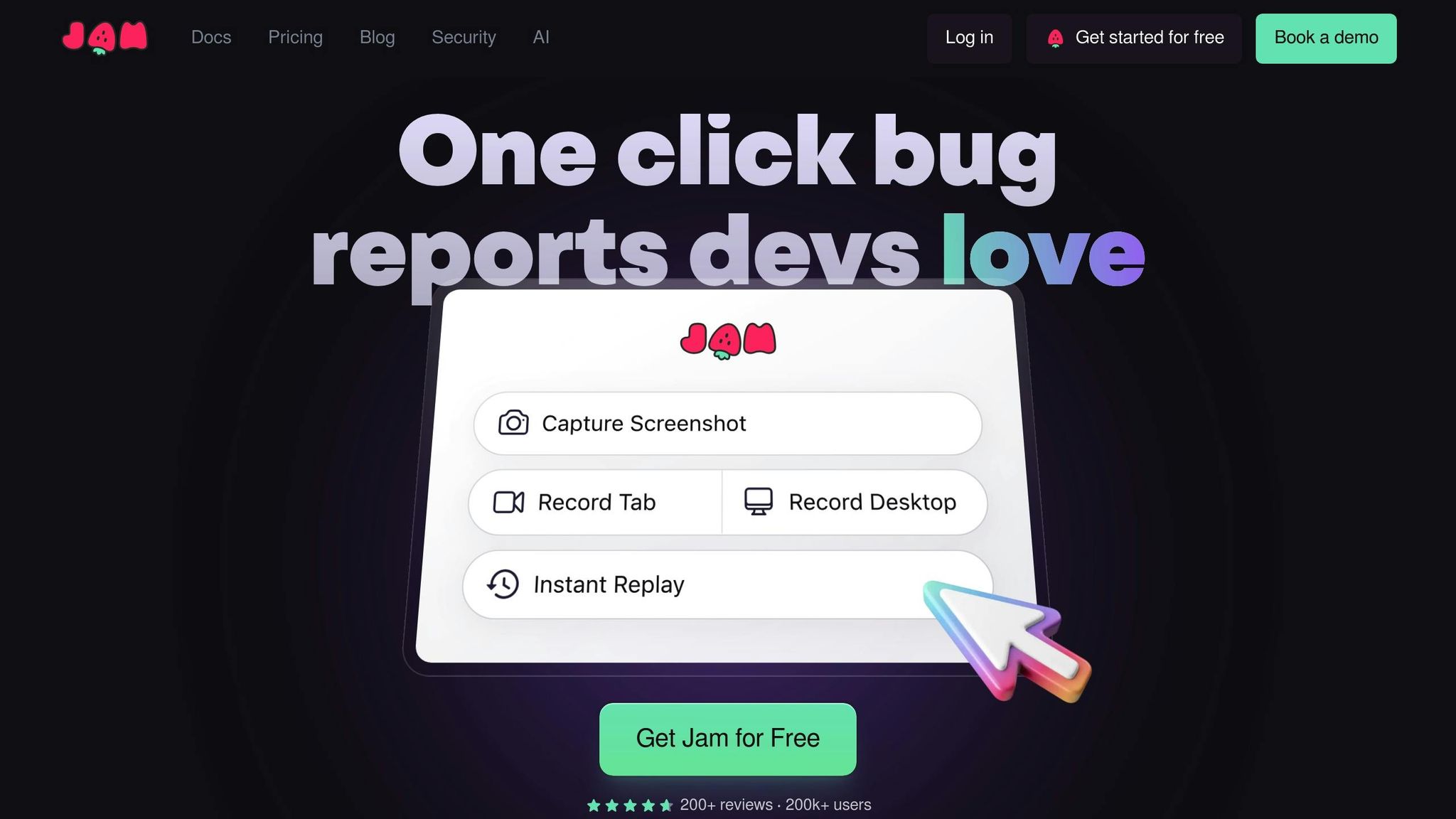
Jam is changing the game for product managers by making technical communication with engineering teams smoother and more efficient. With over 200,000 users and nearly 7 million jams created, this tool simplifies how product issues are identified and resolved, cutting down on the usual back-and-forth between technical and non-technical teams.
Workflow Optimization
Jam takes the headache out of bug reporting. Instead of crafting detailed bug reports, product managers can record their screens, and Jam automatically captures all the technical details developers need - like console logs, network requests, and more. This means developers have everything at their fingertips to reproduce and fix issues quickly.
The impact is striking: teams using Jam report cutting bug resolution time by up to 70%. Matthew Haber, CEO, highlights just how much time this saves:
"With Jam we save between 15 and 60 minutes per ticket. We're dealing with several dozen tickets a week. That's several hours of engineering time per week, that adds up quite a bit."
Jam’s instant replay feature ensures that anyone on the team - technical or not - can capture bugs effortlessly. By simplifying reporting, it boosts team efficiency and speeds up issue resolution.
Collaboration Features
Jam also shines in fostering collaboration between product and engineering teams. Its screen recording and annotation tools make it easy to document bugs clearly, and it integrates seamlessly with platforms like Jira, ClickUp, GitHub, and Slack. This ensures that bug reports fit neatly into existing workflows.
Trip Jagolta, Senior Product Manager, underscores how accessible Jam makes this process:
"Jam's a game changer. Anyone on our team can record a bug and collect error messages without technical expertise."
Practical Applications for Product Management
Jam doesn’t just stop at better reporting - it also helps product managers stay on top of technical issues. By consolidating reproduction steps, console logs, and network data into a single shareable link, it gives teams the full context they need to prioritize tasks effectively.
On top of that, Jam’s AI-powered bug detection and categorization features enable product managers to quickly gauge the severity and impact of issues. Nic Nuyten, Head of Product, sums it up perfectly:
"With Jam you don't need separate resources focusing just on bugs. You can get more done with less people."
7. Monterey AI for Customer Understanding

Monterey AI is changing the way product managers handle customer feedback by turning overwhelming amounts of unstructured data into actionable insights. With an estimated 90% of data being unstructured and difficult to analyze effectively, this Y Combinator-backed platform addresses one of the toughest challenges in product management.
Data Analysis and Insights
Monterey AI simplifies the process of analyzing massive amounts of customer feedback. It pulls data from emails, calls, chats, and social media posts, using AI-powered analytics to extract real-time insights from unstructured information. Product managers can ask questions like, "What are the most frequent user complaints?" and instantly get clear, data-backed answers through the platform's natural language interface.
Teams using Monterey AI report gaining an extra 40 hours of productivity per month per user and solving inbound data requests 70% faster. This efficiency allows product teams to focus on what really matters - delivering meaningful improvements.
"Monterey brings indispensable analytics of user feedback to the forefront for product managers, improving product/market fit and allowing PMs to effectively groom their backlog to prioritize the most impactful feature improvement."
- Dan Grace, Ex VP, TPX, Comcast
Workflow Optimization
The platform doesn’t just analyze feedback - it automates the entire process. Monterey AI routes insights to the right teams, cutting costs by 65% through automation. This eliminates the tedious task of manually sorting through feedback and ensures that critical issues are addressed promptly.
Its visualization tools make it easy to identify trends and patterns in data, presenting insights in a format that’s simple to understand. With support for over 85 languages and locales, Monterey AI is particularly useful for global teams managing diverse customer bases.
In July 2023, a gaming company showcased the platform’s capabilities by using it to analyze thousands of user messages on Discord. Monterey AI automatically flagged messages about errors, glitches, gameplay questions, and feature requests, while also capturing metadata like play frequency and spending patterns.
Collaboration Features
Monterey AI bridges the gap between product teams and customer-facing departments. It integrates seamlessly with over 6,000 apps, including Slack, Jira, HubSpot, Zendesk, Salesforce, and GitHub, ensuring insights flow directly into existing workflows.
Product managers can easily share findings with engineering teams, turning customer feedback into actionable tasks. As co-founder Chun Jiang explains, "It's about using natural language to get meaningful insights and make data-driven product upgrades".
"Monterey AI really shortens the distances between our users and the team."
- Coco Mao, Co-founder, Openart
Practical Applications for Product Management
With Monterey AI, product managers can make smarter decisions about feature prioritization and roadmap planning. The platform highlights which customer needs should drive development, ensuring updates reflect real user demands instead of assumptions.
Young Zhao of Opus Clip shares how the platform transformed his startup: "Monterey AI has been a game-changer for my globally distributed startup. Monterey AI helped me identify customer needs, prioritize features, and collaborate effectively with our engineering and marketing teams. I highly recommend Monterey AI to anyone seeking a next-generation product management solution."
By analyzing surveys and transcripts, the platform provides deeper insights into customer sentiment, enabling quick, informed decisions. This approach helps product managers create offerings that resonate with users, reducing churn and attracting new customers through data-driven improvements.
Garry Tan, President of Y Combinator, underscores the platform’s importance: "Every PM and CEO should use @montereyai. Truly essential product analytics to tell you what is actually happening to your app. Every product in the world will be 10X better if everyone used it."
8. Delibr for Specification Development

Delibr takes the often-daunting task of creating Product Requirements Documents (PRDs) and turns it into a more structured and collaborative process. By focusing on specification development, this platform simplifies one of the most critical aspects of product management: crafting clear and actionable specifications that align teams on what needs to be built - and why.
Workflow Optimization
Delibr makes product management smoother by providing dynamic templates that save time and effort. Instead of starting a PRD from scratch, product managers can use these templates to quickly create tailored documents. Its nested bullet-point structure organizes content hierarchically, making it easier to handle detailed requirements and complex specifications.
The platform also visualizes Epics and PRDs on a board with status columns, giving teams the flexibility to adapt workflows to their specific needs. Starting at $100.00 per month, Delibr offers a complete solution for teams looking to improve their specification processes.
Delibr AI adds another layer of support by offering guidance and feedback during the writing process, helping product managers refine their ideas and develop more detailed documents. As founder Nils Janse puts it, "We couldn't have built Delibr without Delibr", emphasizing how the platform’s capabilities were instrumental in its own development.
Collaboration Features
Delibr’s real-time commenting and editing features make it easy for stakeholders to collaborate directly on documents, cutting down on endless email chains and scattered feedback. The platform encourages structured discussions using methods like the Six Thinking Hats framework to ensure every perspective is considered when making tough decisions.
A built-in question feature allows product managers to tag team members and log answers for future reference, creating a centralized knowledge base for each project. This ensures that key discussions, questions, and decisions are all captured within the project document.
To further streamline workflows, Delibr integrates with popular tools like Jira, Figma, Miro, and Slack. Its two-way Jira integration stands out, letting users create detailed developer tickets directly from conversations within Delibr.
"Delibr has improved our internal product team communication, and discussions are held earlier in the development lifecycle."
- Miika, Information Technology & Services
Practical Applications for Product Management
Delibr empowers product managers to make strategic decisions by integrating input from teams and stakeholders. It excels at producing feature documents that act as a single source of truth for each project, ensuring alignment across the board.
With Delibr, product managers can map user stories, prioritize features, and draft PRDs with AI assistance. The platform’s "Epic Alignment" approach uses user stories as a shared language, framing features from the user’s point of view.
In 2023, Delibr AI introduced Opportunity Solution Trees, which break down problems into actionable solutions and integrate directly with Jira. This feature provides a clear structure for prioritizing features and solving problems effectively.
"Delibr helps me structure my thoughts, notes, and conversations to better document the feature refinement process... every interaction I’ve had with people at Delibr has been exemplary; they’re really a pleasure to work with."
- Gordon, Retail Industry
Users often highlight Delibr’s ease of use and its ability to organize product requirements seamlessly. Its outlining tools consolidate information into one place while enabling smooth collaboration across teams. However, some users have noted that the Jira integration could still use some fine-tuning.
Tool Comparison Chart
Here's a quick side-by-side look at eight AI tools, highlighting their strengths in workflow, analysis, and team collaboration. Use this chart to find the best fit for your team’s needs.
| Tool | Primary Focus | Workflow Efficiency | Data Analysis | Team Collaboration | Starting Price |
|---|---|---|---|---|---|
| BuildBetter | Unified insights from internal & external data | Automates call transcription, meeting summaries, and insight generation | Combines team communications with customer feedback for a complete picture | Real-time AI chat and structured documentation workflows | $7.99/month |
| ChatGPT | Strategic planning & general AI assistance | Automates idea validation, initiative prioritization, and quick insights | Text-based analysis only | Basic conversation interface; no native team features | $20/month (Plus) |
| Zeda.io | Product intelligence & feedback analysis | Connects feedback sources and organizes insights for decision-making | Turns customer feedback into actionable insights with trend analysis | Centralized feedback hub with stakeholder alignment tools | $59/month (Basic) |
| H2O.ai | Predictive analytics & machine learning | Automates model creation and deployment for forecasting | Advanced ML capabilities with predictive modeling and anomaly detection | Model sharing and collaboration features for data teams | Custom pricing |
| ProdPad CoPilot | Roadmap management & product planning | Specialist tool for roadmap creation and product understanding | Product-focused analytics with feature impact assessment | Roadmap sharing and stakeholder communication tools | $6/month per user |
| Jam | Technical collaboration & bug reporting | Streamlines bug reporting with automated context capture | Visual debugging with screenshot and video analysis | Real-time collaboration on technical issues with developers | Free (individual) |
| Monterey AI | Customer understanding & sentiment analysis | Automates customer feedback processing and categorization | Advanced sentiment analysis and customer behavior insights | Customer insight sharing across product and support teams | Custom pricing |
| Delibr | Specification development & PRD creation | Dynamic templates and structured document creation | Limited to document analysis and requirement structuring | Real-time commenting and editing | $100/month |
Now, let’s dive deeper into how these tools perform in workflow efficiency, data analysis, collaboration, and pricing.
Workflow Efficiency Breakdown
Each tool brings its own flair to improving workflows. BuildBetter stands out by automating everything from call recordings to actionable insights, potentially saving teams up to 240 hours per month on its Growing plan. This eliminates the grind of manual note-taking and data entry.
ChatGPT, while versatile, requires manual input for each task, making it more of a generalist tool for quick research and feedback summaries. On the other hand, ProdPad CoPilot focuses on automating roadmaps, combining product knowledge with intuitive planning features.
Zeda.io simplifies feedback management by connecting multiple sources and organizing insights systematically. Meanwhile, Delibr makes PRD creation easier with dynamic templates and structured workflows.
Data Analysis Capabilities
The depth of analysis varies widely across these tools. H2O.ai leads the pack with its machine learning models, offering predictive analytics and anomaly detection. It’s highly rated (4.5/5 on G2 from 24+ reviews) for its advanced capabilities.
BuildBetter takes a broader approach by integrating internal and external data sources, such as team communications and customer surveys, for a well-rounded analysis. This multi-source strategy provides deeper insights compared to tools that focus on single data streams.
Monterey AI specializes in sentiment analysis, helping teams understand customer behavior and emotions. Similarly, Zeda.io excels at turning customer feedback into actionable trends and insights.
Collaboration Features
When it comes to teamwork, Jam shines with its focus on technical collaboration. With a 4.7/5 rating on Product Hunt from 3,400+ upvotes, it’s a favorite for streamlining bug reporting and enabling real-time problem-solving between developers and product managers.
BuildBetter keeps teams aligned with AI-powered internal knowledge queries and structured documentation workflows. Delibr also prioritizes collaboration, offering real-time commenting and editing to ensure everyone stays on the same page.
Pricing and Value Alignment
Pricing reflects the target audience and functionality of each tool. BuildBetter offers an affordable entry point at $7.99/month with unlimited seats, making it a great option for growing teams. ChatGPT, priced at $20/month, provides broad utility but lacks specialized features for product management.
For more niche needs, Zeda.io starts at $59/month for feedback analysis, while Delibr charges $100/month for its PRD-focused capabilities. H2O.ai and Monterey AI rely on custom pricing, which typically suits enterprise-level budgets.
Ultimately, the value of these tools lies in how they integrate with workflows and save time. For instance, BuildBetter claims to save up to 240 hours monthly, while ProdPad CoPilot delivers roadmap-focused efficiency at just $6 per user. Each tool offers a unique mix of features, so the best choice depends on your team’s priorities and budget.
Conclusion
AI tools are transforming how teams process data, predict trends, and handle routine tasks, while also improving collaboration across departments. This shift is not just theoretical - it's backed by real-world results and market projections.
The global AI market is expected to approach $2 trillion by 2030, signaling the vast opportunities ahead. Companies like Dashlane are already seeing the benefits. By leveraging AI-powered tools, they increased their feedback processing rate from 50% to over 80%. Christopher Fox, Dashlane's Director of Product Ops, highlighted this success:
"Productboard AI helps us get straight to the heart of feedback quickly by using AI summaries, making sure we get the feedback to the right product team in a timely manner".
Choosing the right AI tool starts with understanding your team’s unique needs. A solo product manager might prefer flexible, general-purpose tools like ChatGPT, while smaller teams often benefit from collaboration-focused options such as BuildBetter or ProdPad CoPilot. Larger organizations, on the other hand, typically require platforms designed for complex workflows and multiple stakeholders. A step-by-step approach - starting small, measuring outcomes, and scaling thoughtfully - can help ensure long-term success.
Looking ahead, emerging trends like autonomous AI agents, ROI-driven initiatives, hyper-personalization, multimodal models, and digital twins are set to reshape product management.
To thrive in this evolving landscape, product managers need to sharpen their technical skills, craft clear AI strategies, integrate tools effectively, and prioritize ethical considerations. While McKinsey estimates AI could unlock $4.4 trillion in productivity, Gartner warns that 30% of generative AI projects could falter by 2025. The key is to select tools that align with your team’s goals, integrate seamlessly, and demonstrate measurable value. By adopting AI strategically, product managers can enhance efficiency and achieve meaningful results.
FAQs
How can AI tools like BuildBetter boost productivity for product managers?
AI tools, like BuildBetter, are transforming the way product managers work by cutting down on time-consuming tasks and making workflows smoother. They handle repetitive chores, dive deep into data analysis, and deliver insights that product managers can act on. With features like natural language processing and sentiment analysis, these tools help managers grasp customer needs more effectively, allowing them to concentrate on bigger-picture strategies instead of getting bogged down in manual tasks.
Beyond simplifying daily operations, these tools help organize workflows, set task priorities, and even assist in shaping product strategies. This means quicker decisions, smarter use of resources, and better results for the products they manage.
What should product managers look for when selecting an AI tool?
When picking an AI tool, product managers should weigh a few important factors. First up, ease of use. A tool should be straightforward and user-friendly, so your team can hit the ground running without needing hours of training.
Next, think about the total cost of ownership. This includes more than just the initial price tag - factor in ongoing maintenance, updates, and support costs too.
Another key consideration is seamless integration. The tool should work well with your current systems, helping to streamline workflows and boost efficiency. Finally, make sure the tool matches your specific needs, whether that's automating repetitive tasks, analyzing data for insights, or improving team collaboration. The right choice can make a big difference in productivity and smarter decision-making.
How can AI tools help product managers analyze customer feedback to improve their products?
AI tools make it easier for product managers to sift through customer feedback and extract meaningful insights to steer product development. By leveraging natural language processing (NLP) and machine learning, these tools can handle massive amounts of data from surveys, reviews, and support tickets. They identify trends, recurring issues, and customer sentiments almost instantly.
With tasks like categorizing feedback and surfacing actionable insights automated, teams can quickly zero in on what matters most - customer pain points and preferences. This allows product managers to make faster, more informed decisions about updates, prioritize features effectively, and create solutions that truly connect with users. On top of that, AI can anticipate customer needs and tailor interactions, ensuring products keep pace with shifting expectations.